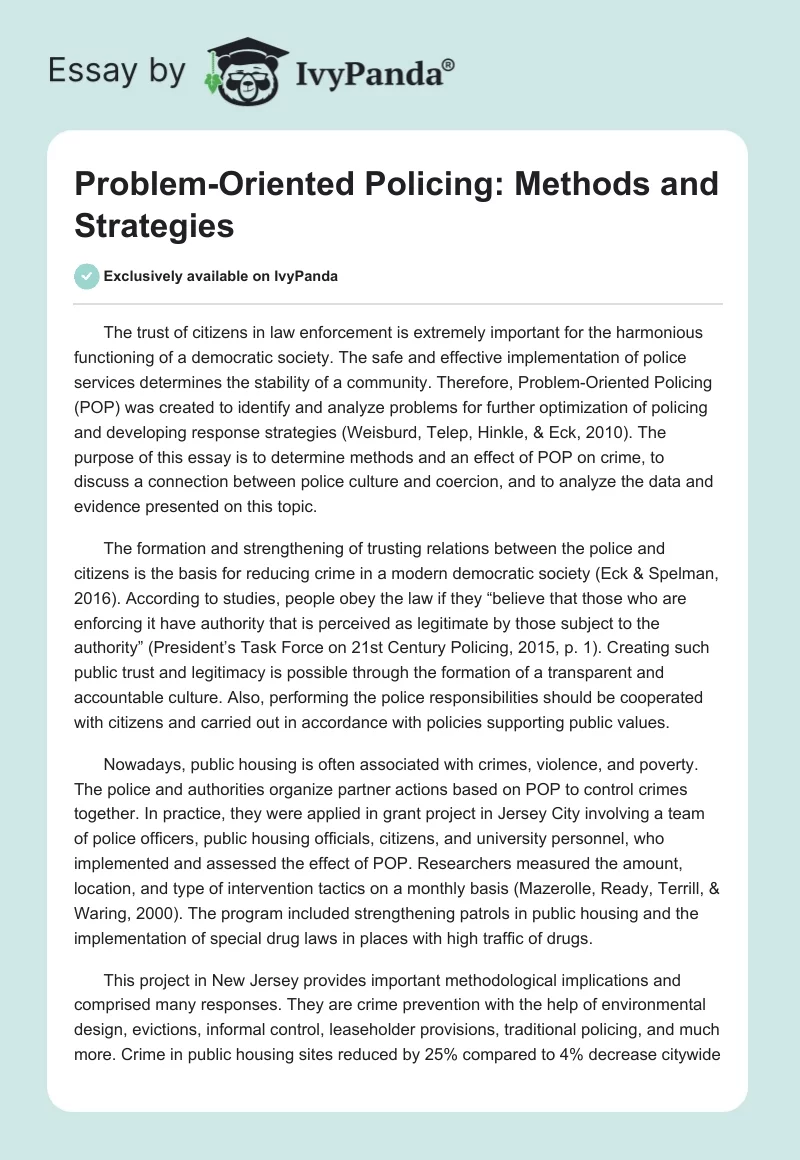The trust of citizens in law enforcement is extremely important for the harmonious functioning of a democratic society. The safe and effective implementation of police services determines the stability of a community. Therefore, Problem-Oriented Policing (POP) was created to identify and analyze problems for further optimization of policing and developing response strategies (Weisburd, Telep, Hinkle, & Eck, 2010). The purpose of this essay is to determine methods and an effect of POP on crime, to discuss a connection between police culture and coercion, and to analyze the data and evidence presented on this topic.
The formation and strengthening of trusting relations between the police and citizens is the basis for reducing crime in a modern democratic society (Eck & Spelman, 2016). According to studies, people obey the law if they “believe that those who are enforcing it have authority that is perceived as legitimate by those subject to the authority” (President’s Task Force on 21st Century Policing, 2015, p. 1). Creating such public trust and legitimacy is possible through the formation of a transparent and accountable culture. Also, performing the police responsibilities should be cooperated with citizens and carried out in accordance with policies supporting public values.
Nowadays, public housing is often associated with crimes, violence, and poverty. The police and authorities organize partner actions based on POP to control crimes together. In practice, they were applied in grant project in Jersey City involving a team of police officers, public housing officials, citizens, and university personnel, who implemented and assessed the effect of POP. Researchers measured the amount, location, and type of intervention tactics on a monthly basis (Mazerolle, Ready, Terrill, & Waring, 2000). The program included strengthening patrols in public housing and the implementation of special drug laws in places with high traffic of drugs.
This project in New Jersey provides important methodological implications and comprised many responses. They are crime prevention with the help of environmental design, evictions, informal control, leaseholder provisions, traditional policing, and much more. Crime in public housing sites reduced by 25% compared to 4% decrease citywide (Mazerolle et al., 2000). Moreover, POP affected interpersonal crimes and property crimes and did not affect drugs, moral offenses, and suspicious persons offenses. Thus, the coercive authority of the police in a POP program can be crucial for changing public housing.
There is a specific connection between police culture and coercion. In 2003, a Systematic Social Observation made a study of the police in Indianapolis and St. Petersburg to examine whether officers embodied the attitudes of the traditional police view were more likely to use coercion in encounters. The traditional police culture view used by some officers consists of a set of values. They are the occupational environment (the physical danger of the police and a unique coercive power) and the organizational environment (interactions with superiors) (Terrill, Paoline, & Manning, 2003).
The study found that pro-culture officers from the Indianapolis were more prone to show aggression compared to St. Petersburg officers promoted the POP approach. Pro-culture-oriented officers in both departments were likely to apply force, but the difference was statistically indistinguishable. Thus, the analysis shows that the template of police culture is misleading. The obtained data complement the understanding of the multifaceted nature of culture.
To sum up, Problem-Oriented Policing is one of the ways to regulate public relations and reduce crime. It is widely used in many police departments. Numerous studies confirm the overall effectiveness of POP but suggest that this approach is not a perfect solution to the problem. Also, it needs the joint complex efforts of the police and authorities. Despite successful statistics, the evidence base in this area invested by the government and the police requires further researching.
References
Eck, J., & Spelman, W. (2016). Problem-oriented policing. Washington, DC.
Mazerolle, L. G., Ready, J., Terrill, W., & Waring, E. (2000). Problem-oriented policing in public housing: The Jersey City evaluation. Justice Quarterly, 17(1), 129-158.
President’s Task Force on 21st Century Policing. Final Report of the President’s Task Force on 21st Century Policing. (2015). Washington, DC: Office of Community Oriented Policing Services.
Terrill, W., Paoline E. A., & Manning, P. K. (2003). Police culture and coercion. Criminology, 41(4), 1003-1034.
Weisburd, D., Telep, C. W., Hinkle, J. C., & Eck, J. E. (2010). Is problem‐oriented policing effective in reducing crime and disorder? Findings from a Campbell systematic review. Criminology & Public Policy, 9(1), 139-172.


